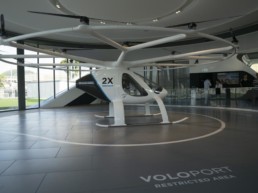Investors deployed an estimated $7 billion of capital into the advanced aerial mobility (AAM) sector last year, riding a wave of excitement about small battery-electric aircraft, including electric flying cars, and urban air taxi services. EVTOL start-ups Lilium, Joby, and Archer went public via SPAC, while Beta and Volcopter raised large amounts of money in private markets at billion-dollar plus valuations. Boeing sank $450MM into Wisk, the eVTOL company started by Larry Page and Sebastian Thrun, which it had struck a joint-venture with in 2019. On the fixed wing side, EQT, the Scandinavian private-equity fund, bet on long-term battery density improvement by investing in Heart Aerospace’s 19-seat all-electric aircraft design.
These deals kicked off a renaissance of innovation in electric motors, batteries, hybrid-electric propulsion, autonomy and other technologies, but has had little commercial impact so far. That is all about to change as the industrial conglomerate Textron has decided to underwrite the expansion and success of electric aviation for commercial use with its acquisition of Pipistrel. Pipistrel has been in business for more than 20 years, built the first certified electric aircraft, and has led the industry in deploying commercial electric aircraft into the market. Textron will acquire Pipistrel in a deal worth $242MM for 90% of Pipistrel’s equity, according to Corporate Jet Investor. This deal will dramatically accelerate the development of both the fixed wing (conventional take-off and landing “CTOL”) and VTOL segments of electric aviation.
Immediate and Long-term Benefits of the Acquisition
This deal offers immediate practical benefit to both parties on the fixed wing side. Textron gets three key platforms it can accelerate: the Electro Alpha, the Panthera and the Nuuva V300.
The Electro is an electric trainer and the world’s first commercially type certified electric aircraft. The Electro helps solve the sustainability problem for flight schools, lowers cost of training, improves safety since electric motors are inherently more reliable and reduces noise issues at tertiary airports. Textron could deploy these aircraft immediately to its own flight schools. Combined with the strong value proposition, Textron’s global distribution footprint, service and parts network, and brand should accelerate the adoption of electric trainers into flight schools around the globe. In addition, The combination of the two companies’ supply chains and Textron’s manufacturing expertise should enable a faster production ramp for this aircraft.
“Aviation must become more sustainable to attract new pilots and retain community support,” says Rob Scholl, the Senior Vice-President of Textron’s electric aviation division. Most observers expect a pilot shortage even without additional demand from new AAM aircraft, so this piece should help Textron ease a major potential bottleneck to industry growth.

Pipistrel Alpha Electro – 100 percent electric airplane is seen in Pruszcz Gdanski, Poland on 14 June 2019 Plane visit to Pruszcz airport was a part of Fortum company promotional flight across the Poland from Wroclaw to Gdansk on full electric plane. Pipistrel Alpha Electro can fly on builtin 21 kW battery for about one hour with speed over 150 kmph (Photo by Michal Fludra/NurPhoto via Getty Images) | NURPHOTO VIA GETTY IMAGES
The Panthera is a four-seat airplane designed to accommodate battery electric, hybrid-electric, and hydrogen powertrains. It offers Textron a potential electric entry into the lower end of the air taxi market and four-seat private aviation market. It would fill a high-performance gap not covered by the Cessna 172 Skyhawk and 182 Skylane and enable Cessna to become more competitive with Cirrus and Diamond in that niche.

BOTSWANA – 2014/06/11: Cessna 208 Caravan at the landing strip of Vumbura Plains in northern part of Botswana. (Photo by Wolfgang Kaehler/LightRocket via Getty Images) | LIGHTROCKET VIA GETTY IMAGES
Along the same lines, the deal could also lead to significant changes to Textron’s Bell Helicopter portfolio. Hybridization has less traction in the urban air mobility market at the moment than with fixed wing aircraft. However, hybridization is even more compelling in the eVTOL segment given the power requirements and challenges some competitors have had with hitting range targets.
Dr. Tine Tomazic, Pipistrel’s Chief Technical Officer, hinted at the full potential impact Pipistrel’s experience could generate in his comments about propulsion systems. Tomazic believes that the major propulsion systems — battery electric, hybrid electric and hydrogen — all have a role to play in the emerging aviation ecosystem. Battery-electric could address aircraft up to about 10 seats over time with hybrid-electric and hydrogen addressing markets for larger aircraft. “The trade-off between battery-electric and hybrid-electric is between weight and energy density,” says Tomazic. “The more energy conversion you do, the more efficiency you lose — from 90%+ to around 60% when you move from battery-electric to hybrid. However, batteries also add weight that offset the efficiency gains.”
Kevin Noertker, CEO of Ampaire a supplier of hybrid-electric systems, endorses this view, “Hybrid makes sense for missions that require more range, with heavier aircraft weight and more passengers.” It isn’t hard to imagine Tomazic quickly getting engaged with the hybrid programs Textron started with Surf Air Mobility and Ampaire for the Caravan or igniting a discussion about hybrid-electric at Bell.
Industry Impact
The merger could have a substantial impact on the electric aviation industry. Making real progress flying will help accelerate the development of demand in electric aircraft markets. Having electric aircraft deployed and operating at scale should reduce potential customer anxiety about new aircraft types, help build out a more robust supply chain for these types of aircraft, and spur infrastructure investment that will facilitate a wave of larger aircraft in the second half of the decade.
It may also set off a race to lock up the most attractive electric assets on the fixed wing side as traditional OEM psychology changes from wait and see to fear of missing out. “Nobody wants to miss the biggest disruption in aircraft propulsion since the introduction of the jet engine — especially in the hybrid-electric sector, which can enable electrification in larger, more valuable aircraft that have a balance of performance and efficiency that will stimulate the market,” says Eric Bartsch, CEO and Co-founder of VerdeGo Aero. Expect lots of investment action in the hybrid-electric propulsion space by Textron and others in the months to come. In the end, there are just not that many well-advanced assets in the fixed wing and propulsion spaces. Look for them to get locked up quickly.
Finally, the deal will change market psychology around electric aviation generally. The practical nature of this deal with its short to medium-term impact on the small aircraft space will move investors from the forward-looking enthusiasm around urban air mobility that swept up the industry last year towards realistic, achievable goals that the industry can scale in the near term.
When we reflect on the industry’s development 10 years hence, Textron’s acquisition of Pipistrel could have greater foundational impact than the early fundraising successes in eVTOL With this deal, electric aviation has reached take-off.
Original article published in Forbes on Mar 20, 2022.


